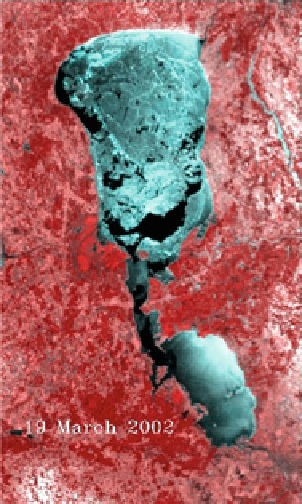Geoscience Reference
In-Depth Information
Fig. 5.11
Ice situation in Lake
Peipsi according to MODIS
imagery, 19 March 2002. The
dark elongated zones on the
western and central coasts
indicate major leads, and small
leads and fractures can also be
seen far from the coast
broken ice is a granular medium called
, and here, as usual, a continuum
approximation is employed for this medium. The motion of drift ice takes place in the
three-dimensional world, but it can be treated as a
drift
ice
phenomenon on the
lake surface. In sea ice basins, ice drift is a common phenomenon with major short-term
and climatological impacts, and the theory and models of sea ice dynamics are now well-
developed and applicable to lake ice covers (e.g., Leppäranta 2011).
From the point of view of ice mechanics,
two-dimensional
are those, in which wind-driven
mechanical displacements are common. In small and medium-size lakes the ice cover is
static, apart from fractures and thermal cracks. Fetch is the critical factor for the ice
displacements, and therefore islands can limit the mobility of ice in large lakes such as
Lake Saimaa in Finland. A linear dimension of 100 km can be taken as a convenient
magnitude for lakes where ice displacements occur regularly.
In Europe there are
'
large lakes
'
five large lakes, where major ice displacements are common: the
Caspian Sea, Ladoga, Onega, Peipsi, and Vänern (see Burda 1999; Wang et al. 2006). Ice
forms annually in the northern part of the Caspian Sea, where it is mostly drift ice. As an
example, Fig.
5.11
shows the ice conditions in Lake Peipsi for March 19, 2002. In Asia,
wind-driven ice is observed in the Aral Sea (Kouraev et al. 2004) and in Lake Baikal. Drift
ice is also common in the Great Lakes of North America. In between large and medium-
size lakes, there is a grey area: the ice cover is static in cold winters and may be mobile in
mild winters. An example is Lake Lappajärvi (63°12
E), a medium-size lake in
Finland. Its surface area is 148 km
2
and its mean and maximum depths are 7.4 m and
36 m, respectively. The lake basin depression is a wide meteorite impact crater. It is
′
N23°42
′


Search WWH ::

Custom Search